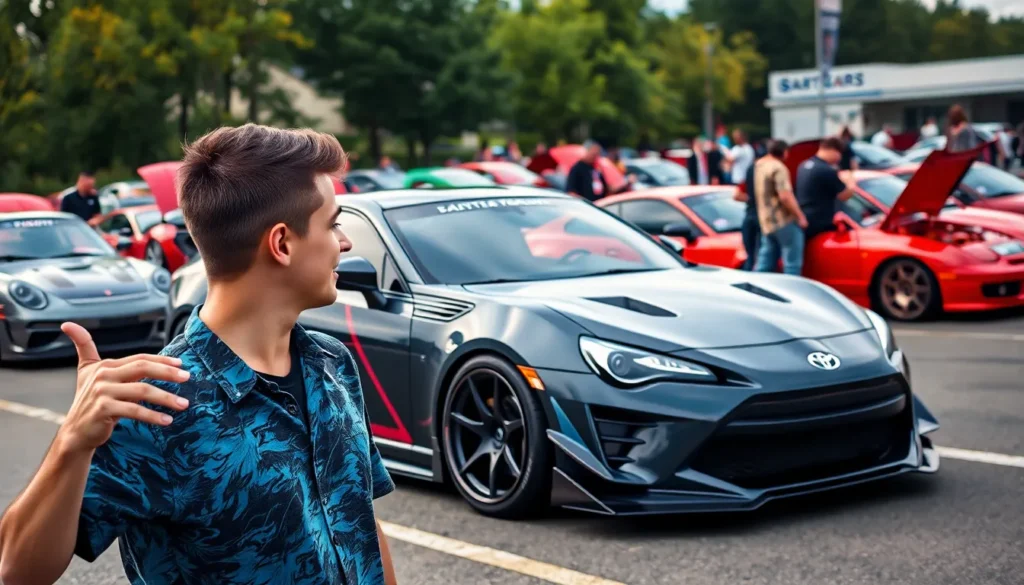The Toyota 86 has captured the hearts of driving enthusiasts worldwide and for good reason. This lightweight rear-wheel-drive sports car offers the perfect canvas for modification with its balanced chassis and affordable price point making it a tuner’s dream come true.
We’ve seen countless 86 builds that transform this already impressive platform into something truly spectacular. From aggressive widebody kits and lowered suspensions to forced induction setups that double the horsepower the modification possibilities are virtually endless. Whether you’re chasing track times or street credibility the 86 responds beautifully to thoughtful upgrades.
The beauty of modifying a Toyota 86 lies in its versatility. You can build a weekend track weapon with lightweight wheels and performance tires or create a show-stopping stance build that turns heads at every car meet. We’ll explore the most popular modification paths proven upgrade combinations and essential tips to help you unlock your 86’s full potential without very costly.
What Makes the Toyota 86 Perfect for Modification
Lightweight architecture forms the foundation of exceptional Toyota 86 modification potential. The car weighs just 2,758 pounds in base trim, creating an ideal power-to-weight ratio that responds dramatically to performance upgrades. Engineers designed the chassis with a low center of gravity at 18.1 inches, positioning the engine behind the front axle line for near-perfect 53:47 weight distribution.
Rear-wheel drive configuration opens countless modification pathways that front-wheel drive platforms can’t match. Enthusiasts can install limited slip differentials, coilover suspension systems, and aggressive wheel setups without worrying about torque steer or understeer issues. The traditional drivetrain layout accommodates everything from mild handling improvements to complete track-focused transformations.
Key modification advantages include:
- Accessible engine bay – Naturally aspirated FA20 boxer engine provides ample space for turbocharger kits, intake systems, and exhaust modifications
- Robust transmission – Six-speed manual gearbox handles increased torque from forced induction setups up to 350 wheel horsepower
- Suspension geometry – MacPherson strut front and double wishbone rear setup accepts wide range of aftermarket components
- Aerodynamic body – Clean lines work with front splitters, rear wings, and side skirts without disrupting airflow
Toyota’s parts availability makes 86 modification projects cost-effective compared to European sports cars. OEM components share designs with the Subaru BRZ and Scion FR-S, tripling the aftermarket support base. Performance shops stock everything from basic bolt-ons to complete engine swap kits.
| Modification Category | Stock Specification | Typical Upgrade Potential |
|---|---|---|
| Horsepower | 205 hp | 250-400 hp |
| Torque | 156 lb-ft | 200-350 lb-ft |
| Suspension Drop | Stock Height | 1-3 inches lower |
| Wheel Width | 7.5 inches | 8-10 inches |
The 86’s platform accepts modifications without compromising daily drivability when done properly. Street-focused builds maintain comfortable ride quality while adding 50-75 horsepower through intake, header, and tune combinations. Track-oriented setups push boundaries with roll cages, racing seats, and stripped interiors while preserving the car’s fundamental balance.
Popular Engine Modifications for the Toyota 86
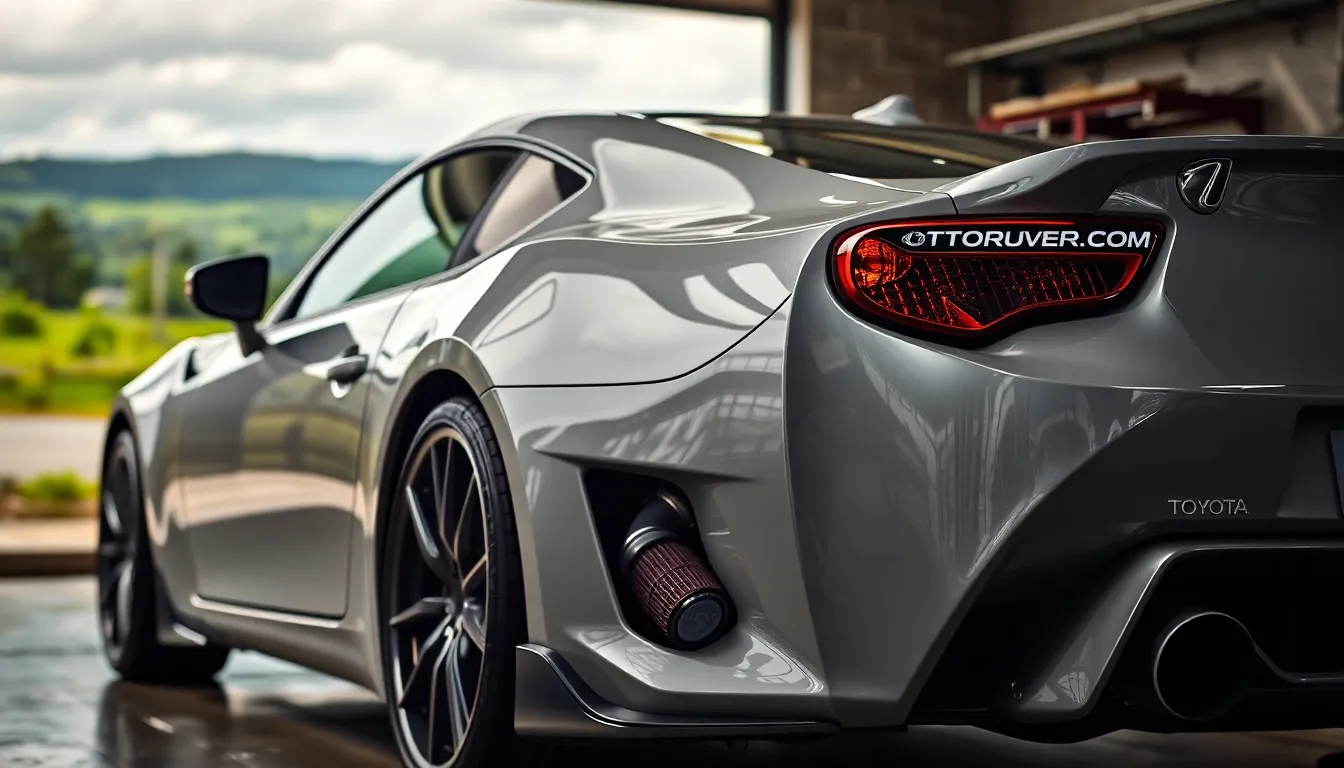
The naturally aspirated FA20 engine in the Toyota 86 responds exceptionally well to forced induction and supporting modifications. These engine upgrades transform the car’s power delivery characteristics while maintaining the balanced driving dynamics that make the platform so appealing.
Turbocharger and Supercharger Kits
Turbocharger kits represent the most dramatic power increase available for the Toyota 86 platform. Companies like Jackson Racing, Sprintex, and Vortech offer complete turbo systems that boost output from the stock 200 horsepower to 280-350 horsepower depending on boost levels and supporting modifications. These kits include custom piping, intercoolers, and engine management tuning to ensure reliable operation.
Supercharger systems provide linear power delivery that complements the 86’s naturally aspirated characteristics. The Sprintex centrifugal supercharger kit produces approximately 270 horsepower at 8 PSI boost while maintaining excellent throttle response throughout the rev range. Installation typically requires 15-20 hours of labor and costs between $4,500-$6,500 for complete systems.
Both forced induction options require supporting modifications including upgraded fuel injectors, high flow fuel pumps, and professional engine tuning. The stock FA20 internals handle up to 300 wheel horsepower reliably with proper tuning and octane requirements.
Exhaust System Upgrades
Cat back exhaust systems unlock additional horsepower while dramatically improving the FA20’s sound characteristics. Popular manufacturers like Invidia, Borla, and HKS offer systems that increase power output by 8-15 horsepower through reduced backpressure and optimized exhaust flow.
Header modifications provide the most important naturally aspirated power gains. Aftermarket headers from companies like Tomei, Gruppe-S, and Crawford Performance replace the restrictive stock equal length headers with unequal length designs that improve exhaust scavenging. These modifications typically add 12-18 horsepower when combined with proper engine tuning.
Overpipe replacements eliminate the restrictive catalytic converter section between the headers and main catalytic converter. This modification adds 5-8 horsepower and improves throttle response, though it may affect emissions compliance in certain states.
Cold Air Intake Systems
Cold air intake systems replace the restrictive stock airbox with high flow filters and optimized intake piping. Manufacturers like AEM, K&N, and Mishimoto offer systems that reduce intake air temperatures by 10-15 degrees Fahrenheit while increasing airflow capacity.
Drop in filter upgrades provide a cost effective first modification for Toyota 86 owners. High flow filters from companies like aFe Power and Blitz increase airflow by 15-25% over stock paper filters while maintaining filtration efficiency. These modifications cost $50-$80 and require no additional tuning.
Complete intake system replacements maximize airflow potential through larger diameter piping and relocated filter positioning. These systems produce 5-10 horsepower gains when combined with exhaust modifications and engine tuning. Installation typically takes 2-3 hours and costs between $250-$400 for quality systems.
Suspension and Handling Upgrades
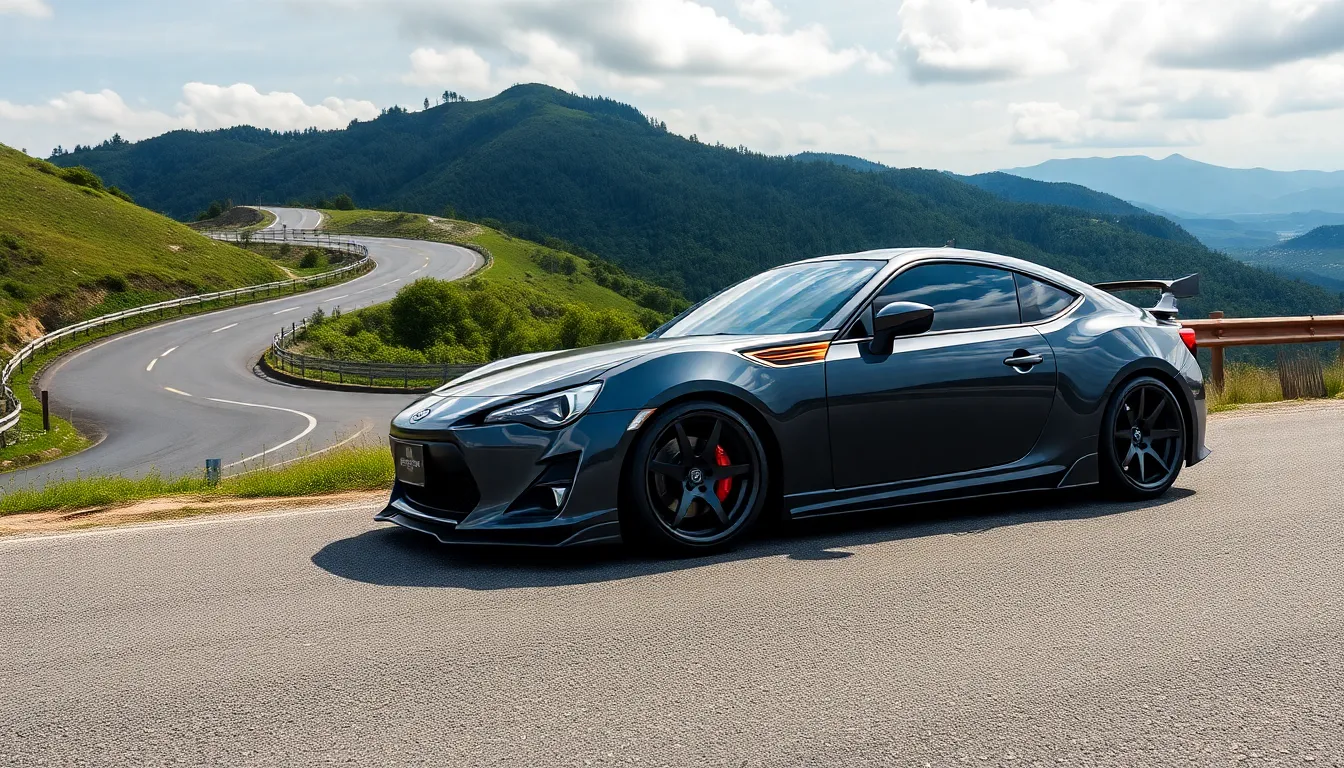
Suspension modifications transform the Toyota 86’s handling characteristics more dramatically than any other upgrade category. These enhancements reduce body roll, improve cornering precision, and create a more connected driving experience that maximizes the car’s lightweight rear-wheel-drive platform.
Coilover Systems and Lowering Springs
Coilover systems provide the most comprehensive suspension upgrade for the Toyota 86, offering adjustable ride height, damping control, and spring rates. Popular options include the Tein Flex Z ($800-1,200), KW V3 ($1,800-2,200), and Ohlins Road & Track ($2,500-3,000), each delivering distinct performance characteristics for different driving styles.
Lowering springs present a budget-friendly alternative that maintains the stock dampers while reducing ride height by 1.0-1.5 inches. The Eibach Pro-Kit drops the 86 by 1.2 inches front and 1.0 inches rear, improving aerodynamics and lowering the center of gravity without compromising daily drivability. Swift Sport Springs offer a more aggressive 1.5-inch drop with increased spring rates that enhance cornering response.
Adjustable coilovers allow fine-tuning for track events, autocross competitions, or street driving preferences. Most systems feature 16-32 clicks of damping adjustment, enabling drivers to dial in compression and rebound settings for exact conditions. Track-focused setups typically use stiffer spring rates (8-10 kg/mm front, 6-8 kg/mm rear) compared to street builds (6-8 kg/mm front, 4-6 kg/mm rear).
Sway Bars and Strut Braces
Anti-roll bars (sway bars) significantly reduce body roll during cornering while maintaining ride comfort over bumps and road imperfections. The Whiteline 24mm rear sway bar represents one of the most effective single modifications for the Toyota 86, reducing understeer and creating more neutral handling characteristics for $200-300.
Front strut tower braces connect the shock towers to increase chassis rigidity and improve steering precision. The Cusco Type OS strut brace ($150-200) bolts directly to the factory mounting points and provides measurable improvements in steering feedback during spirited driving. Ultra Racing offers a more comprehensive 3-point brace system that ties the strut towers to the firewall for enhanced rigidity.
Chassis bracing extends beyond strut towers to include lower tie bars, fender braces, and tunnel braces that work together as a system. The Perrin Performance lower tie bar ($180-220) connects the front subframe to reduce flex under hard cornering loads. TRD offers a complete chassis brace package that includes front, side, and rear reinforcements designed specifically for the 86’s unibody construction.
Wheels and Tire Combinations
Lightweight wheels reduce unsprung weight and improve acceleration, braking, and handling response more effectively than most other modifications. Popular 17-inch options include the Enkei RPF1 (14.8 lbs), Work Emotion CR Kiwami (15.2 lbs), and Volk Racing TE37 (15.6 lbs), each offering important weight savings over the stock 18-inch wheels.
Tire selection dramatically impacts the Toyota 86’s performance potential, with compound and tread pattern choices determining grip levels and handling characteristics. Michelin Pilot Sport 4S tires in 215/45R17 or 225/45R17 provide excellent all-weather performance, while Bridgestone Potenza RE-71R offers maximum dry grip for autocross and track events.
| Wheel Size | Popular Tire Size | Weight Reduction | Performance Focus |
|---|---|---|---|
| 17×8 +35mm | 215/45R17 | 8-12 lbs per wheel | Autocross/Track |
| 17×9 +35mm | 225/45R17 | 6-10 lbs per wheel | Street/Track |
| 18×8.5 +35mm | 225/40R18 | 4-8 lbs per wheel | Street Performance |
Wheel sizing affects performance differently based on intended use, with 17-inch setups favoring acceleration and ride quality while 18-inch wheels accommodate larger brake upgrades. The 17×8 +35mm specification with 215/45R17 tires creates the optimal balance of weight savings, tire selection, and clearance for most Toyota 86 applications.
Exterior Modifications That Transform the Look
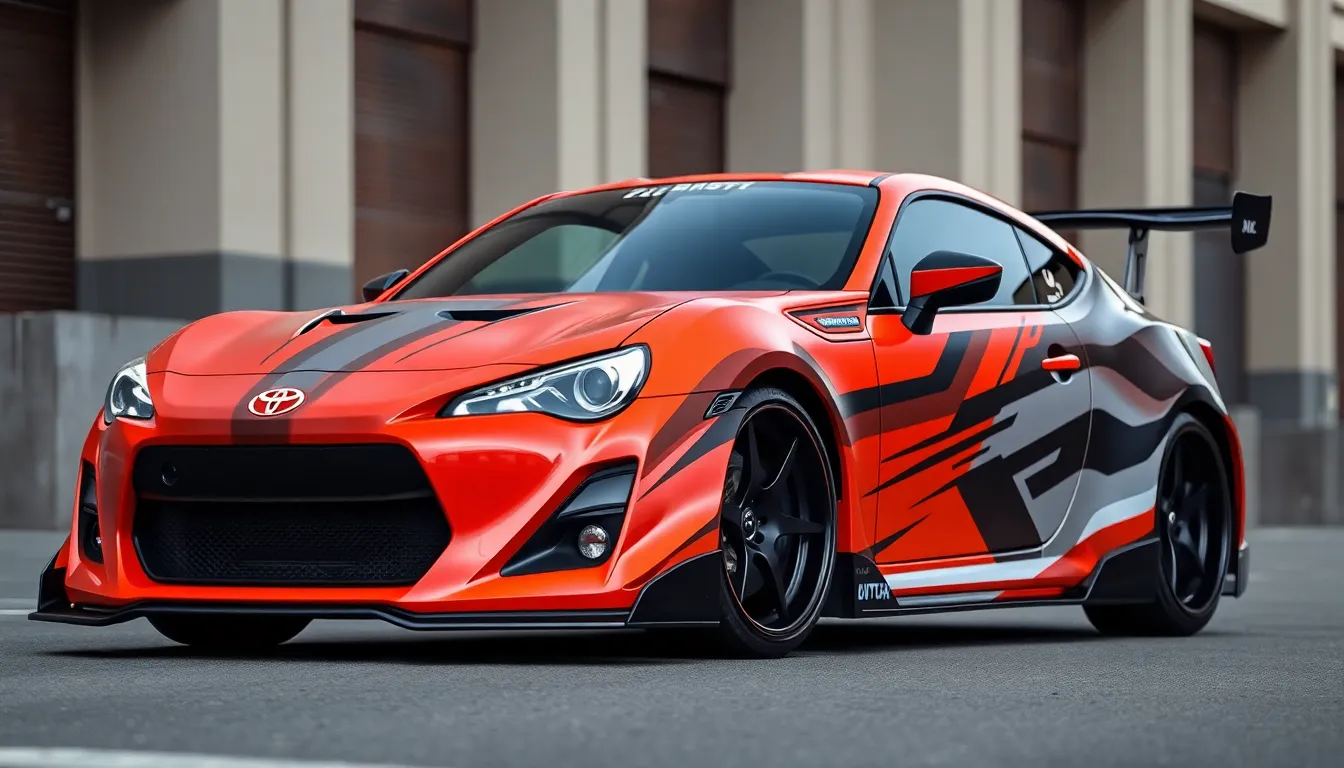
Exterior modifications dramatically change the Toyota 86’s visual impact while often providing functional benefits. We’ve identified the most effective styling upgrades that elevate the car’s appearance from subtle enhancements to complete transformations.
Body Kits and Aerodynamic Enhancements
Widebody kits represent the most dramatic exterior transformation for the Toyota 86. Rocket Bunny and Pandem offer aggressive flare extensions that accommodate wider wheels and tires while creating an imposing stance. These kits typically add 2-4 inches of width per side and require professional installation.
Front splitters and rear wings provide both aesthetic appeal and functional downforce. Popular options include the STI front splitter which adds subtle aggression and the APR GTC-300 adjustable wing that generates measurable downforce at track speeds. Side skirts complete the aerodynamic package by smoothing airflow along the car’s flanks.
Diffusers enhance the rear end’s visual complexity while managing underbody airflow. Brands like Verus Engineering offer carbon fiber diffusers that integrate seamlessly with the 86’s rear bumper design. These components typically cost between $300-800 depending on material and complexity.
Duck tail spoilers provide a more subtle alternative to large wings. The OEM STI spoiler adds factory-approved styling while aftermarket options from companies like Seibon offer carbon fiber construction and unique profiles.
Custom Paint and Vinyl Wraps
Vinyl wraps offer unlimited color and design possibilities without permanent paint modification. Full vehicle wraps typically cost $2,500-4,500 and can be removed to restore the original finish. Popular wrap finishes include matte black, satin white, and chrome delete packages that eliminate factory chrome trim.
Racing stripes and accent graphics create visual drama at lower costs. Side stripes running the car’s length cost approximately $200-500 installed and come in various widths and colors. Roof wraps in contrasting colors like black or carbon fiber patterns add visual interest for $300-600.
Custom paint jobs provide permanent color changes with superior durability compared to wraps. Single-stage paint jobs start around $3,000 while high-quality multi-stage finishes can exceed $8,000. Popular custom colors include BMW’s Estoril Blue, Porsche’s Guards Red, and custom mixed metallics.
Carbon fiber overlays enhance exact body panels without full replacement. Hood wraps simulate carbon fiber appearance for $400-700 while actual carbon fiber hoods from companies like Seibon cost $1,200-2,000. Mirror caps, door handle covers, and B-pillar wraps complete the carbon fiber aesthetic for additional $200-400.
Plasti Dip offers temporary color changes and protection for wheels and trim pieces. This removable coating costs $50-150 for DIY application and allows experimentation with different color schemes before committing to permanent modifications.
Interior Upgrades for Enhanced Driving Experience
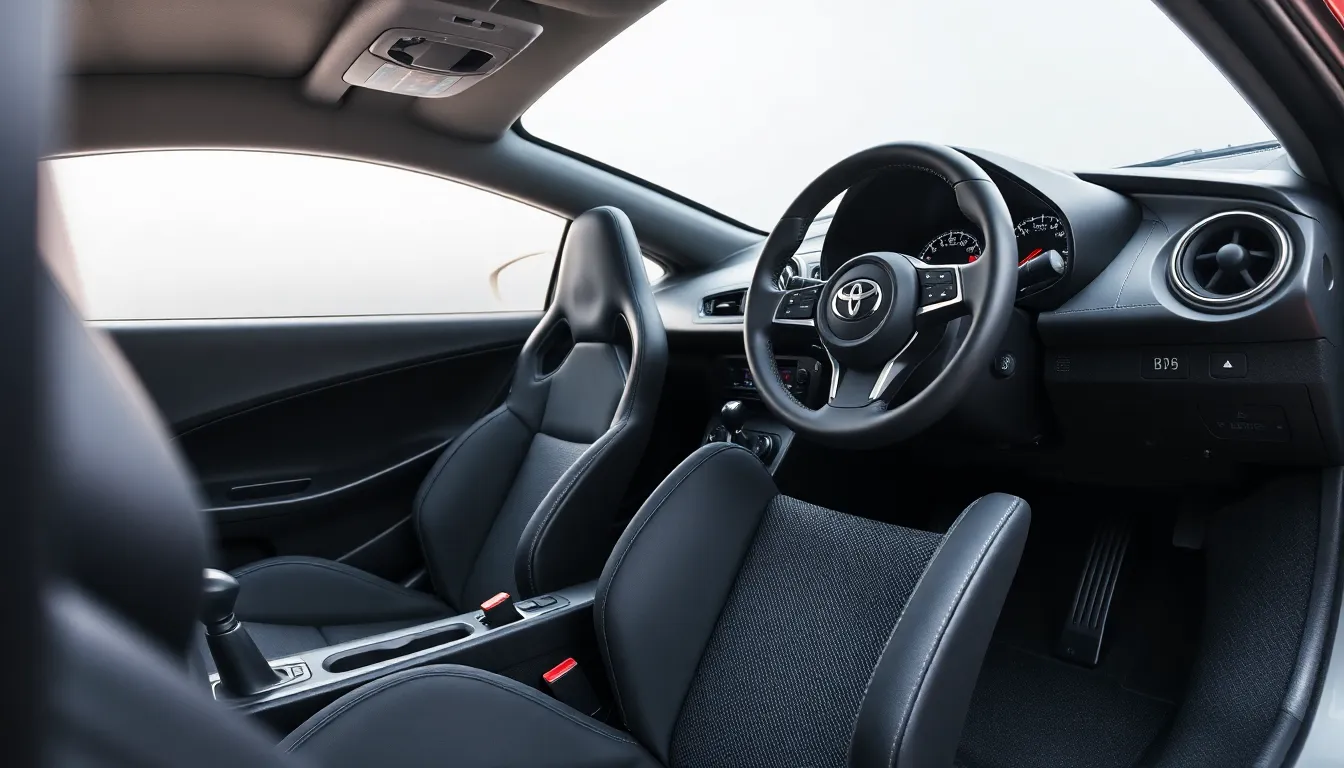
Interior modifications transform the Toyota 86’s cabin into a performance-focused environment while maintaining comfort for daily driving. These upgrades enhance driver connection and provide essential feedback during spirited driving sessions.
Racing Seats and Harnesses
Racing seats offer superior support compared to the stock Toyota 86 seats during aggressive cornering and track events. Recaro Sportster CS seats provide excellent lateral support with 4-way adjustability, while Bride Zeta III seats deliver track-focused containment with lightweight construction. Fixed-back bucket seats like the Sparco Sprint reduce weight by 15-20 pounds compared to factory seats.
Harness systems complement racing seats by securing the driver more effectively than standard seat belts. 4-point harnesses from Takata or Schroth distribute crash forces across the chest and shoulders. 6-point harnesses add anti-submarine belts for maximum security during track use. Harness bars mount behind the seats to provide proper anchor points at the correct angle.
Side-mount brackets accommodate different seat brands and maintain proper seating position relative to pedals and steering wheel. Slider systems allow seat adjustment for multiple drivers while retaining the performance benefits of aftermarket seats. Bottom-mount installations typically require custom fabrication but offer the lowest seating position.
Performance Steering Wheels and Gauges
Performance steering wheels reduce diameter from the stock 14.5 inches to 13-13.5 inches for quicker steering inputs and improved feel. Sparco R345 wheels feature a 350mm diameter with suede grip areas and lightweight construction. Momo Mod 07 wheels provide classic 3-spoke design with perforated leather sections. Quick-release hubs allow wheel removal for easier entry and theft prevention.
Additional gauges monitor critical engine parameters that the stock cluster doesn’t display. Boost gauges track turbocharger or supercharger pressure for forced induction builds. Oil temperature gauges ensure engine oil stays within optimal operating ranges during track sessions. Wideband air/fuel ratio meters help tune engine management systems for maximum performance.
Digital gauge clusters replace analog displays with customizable LCD screens showing multiple parameters simultaneously. AiM MXS displays provide data logging capabilities along with real-time monitoring. Stack ST8100 units offer professional-grade features with CAN bus integration for comprehensive vehicle monitoring.
Steering wheel mounted controls keep essential functions within thumb reach. Paddle shifters for automatic transmissions mount directly to the wheel spokes. Horn buttons integrate seamlessly into aftermarket wheel designs while maintaining factory functionality. Switch panels accommodate additional controls for nitrous systems or electronic boost controllers.
Cost Breakdown of Popular Toyota 86 Modifications
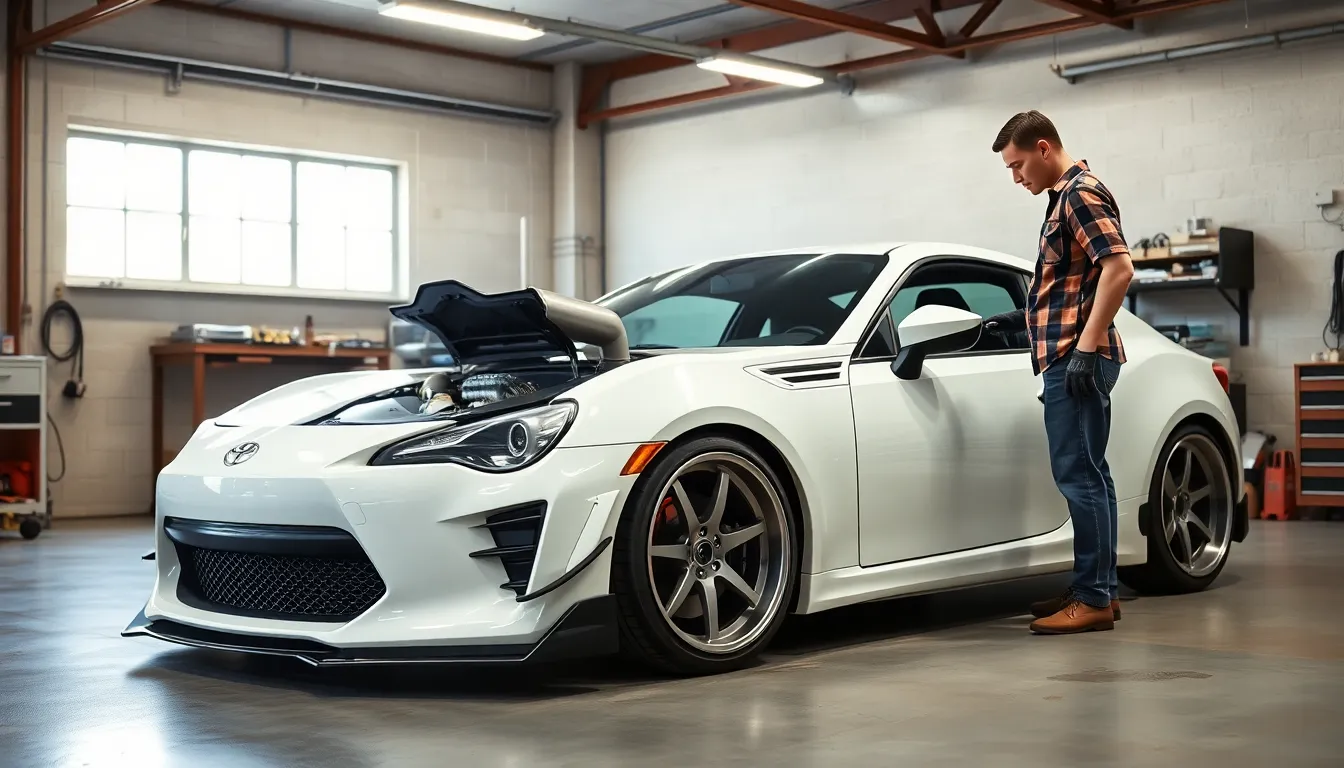
Performance modifications for the Toyota 86 span a wide price range, allowing enthusiasts to enhance their vehicle within virtually any budget. Understanding modification costs helps prioritize upgrades and plan builds effectively.
Engine Modification Costs
Forced induction systems represent the most important single investment for Toyota 86 owners seeking substantial power gains.
| Modification Type | Price Range | Installation Cost | Total Investment |
|---|---|---|---|
| Turbocharger Kit | $4,500-$8,000 | $1,200-$2,500 | $5,700-$10,500 |
| Supercharger Kit | $5,500-$9,500 | $800-$1,800 | $6,300-$11,300 |
| ECU Tune | $400-$800 | $200-$400 | $600-$1,200 |
| Cold Air Intake | $200-$500 | $0-$150 | $200-$650 |
| Header/Exhaust Combo | $800-$2,000 | $300-$600 | $1,100-$2,600 |
Popular turbocharger systems like the Jackson Racing or HKS GT Supercharger offer excellent value considering their power output increases. Supercharger kits typically cost more upfront but require less supporting modification investment.
Supporting engine modifications add substantial costs when pursuing forced induction. Upgraded fuel injectors cost $300-$600, while fuel pumps range from $250-$500. Intercooler systems for turbocharged builds add $600-$1,200 to the total investment.
Suspension and Handling Upgrade Pricing
Suspension modifications offer some of the best performance-per-dollar improvements for the Toyota 86 platform.
| Component | Budget Option | Mid-Range | High-End |
|---|---|---|---|
| Coilovers | $800-$1,200 | $1,500-$2,500 | $3,000-$5,000 |
| Lowering Springs | $150-$300 | $300-$500 | $500-$800 |
| Sway Bars (Front/Rear) | $200-$400 | $400-$600 | $600-$1,000 |
| Strut Tower Brace | $100-$200 | $200-$350 | $350-$600 |
Coilover systems from brands like BC Racing or Tein provide excellent adjustability at moderate price points. Premium options such as Öhlins or KW Variant 3 justify their higher costs through superior damping technology and build quality.
Wheel and tire combinations significantly impact both performance and aesthetics while offering various price tiers.
| Wheel Size | Budget Wheels | Performance Tires | Total Set Cost |
|---|---|---|---|
| 17×8 | $600-$1,000 | $600-$900 | $1,200-$1,900 |
| 18×8.5 | $800-$1,400 | $800-$1,200 | $1,600-$2,600 |
| 18×9.5 | $1,000-$2,000 | $900-$1,400 | $1,900-$3,400 |
Exterior Modification Investment
Visual modifications range from affordable cosmetic updates to comprehensive body kit installations requiring professional expertise.
Widebody kits command premium pricing due to their complexity and installation requirements. Rocket Bunny V2 kits cost $3,500-$4,500 before paint and installation. Pandem widebody systems range from $4,000-$6,000 depending on the exact variant chosen.
| Exterior Modification | Cost Range | Installation |
|---|---|---|
| Front Splitter | $200-$800 | $100-$300 |
| Rear Wing | $300-$1,500 | $150-$400 |
| Side Skirts | $400-$1,000 | $200-$500 |
| Diffuser | $250-$700 | $100-$250 |
| Full Paint Job | $3,000-$8,000 | Included |
| Vinyl Wrap | $2,000-$4,000 | $500-$1,000 |
Carbon fiber components cost significantly more than fiberglass alternatives but offer weight savings and premium appearance. Carbon fiber hoods range from $800-$2,000, while fiberglass options cost $300-$800.
Interior Enhancement Costs
Interior modifications focus on improving driver connection and comfort during spirited driving sessions.
Racing seats represent the most impactful interior upgrade for performance-oriented builds. Recaro Sportster CS seats cost $1,200-$1,800 each, while Bride Zeta III options range from $1,800-$2,500 per seat. Budget alternatives like Corbeau A4 seats provide excellent support for $400-$600 each.
| Interior Component | Budget | Mid-Range | Premium |
|---|---|---|---|
| Racing Seats (Pair) | $800-$1,200 | $2,000-$3,000 | $3,500-$5,000 |
| Harness System | $200-$400 | $400-$700 | $700-$1,200 |
| Steering Wheel | $150-$300 | $300-$600 | $600-$1,000 |
| Gauge Cluster | $200-$500 | $500-$1,000 | $1,000-$2,000 |
Performance steering wheels from Sparco or OMP enhance driver feedback while maintaining comfortable ergonomics. Additional gauges monitoring boost pressure, oil temperature, and air-fuel ratio cost $100-$300 each but provide crucial engine monitoring capabilities for modified vehicles.
Labor costs vary significantly by region and shop expertise, with specialty Toyota 86 tuners commanding premium rates for their experience and knowledge of the platform’s exact requirements.
Top Modified Toyota 86 Builds to Inspire Your Project
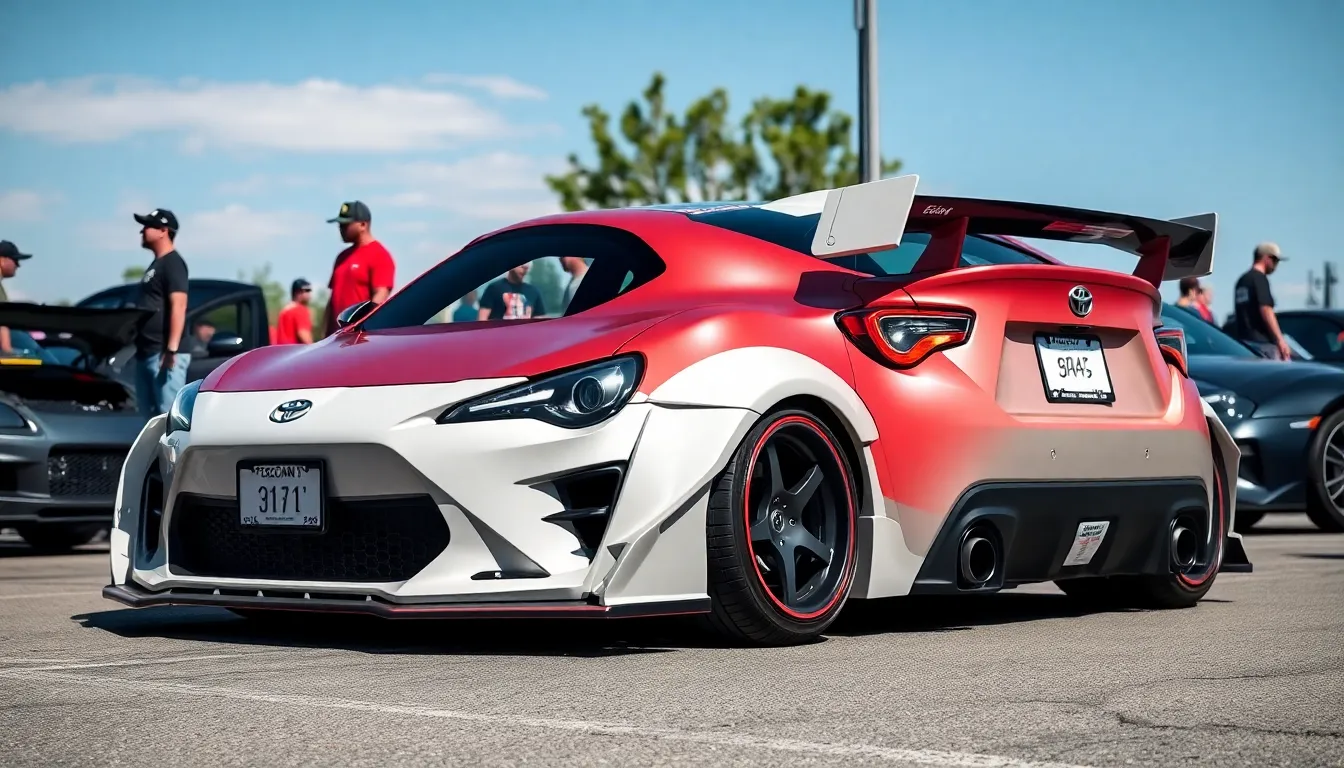
Professional builders have transformed the Toyota 86 into remarkable machines that demonstrate the platform’s incredible modification potential. These builds showcase diverse approaches to improving performance, aesthetics, and functionality while maintaining the car’s essential character.
Widebody Track Monster Builds
Rocket Bunny Pandem kits create the foundation for aggressive track-focused builds that combine visual drama with serious performance upgrades. StanceWorks’ BRZ build features a complete Pandem V3 widebody kit paired with Öhlins coilovers, Work Emotion CR Ultimate wheels, and a comprehensive aero package. The build produces 310 horsepower through a Vortech supercharger system and demonstrates how extreme styling enhances aerodynamic efficiency.
Adam LZ’s drift-spec Toyota 86 incorporates a Rocket Bunny V2 kit with functional venting modifications that improve cooling during extended track sessions. Custom fabricated roll cage elements provide structural rigidity while maintaining the car’s lightweight characteristics. The build achieves 340 horsepower through a Jackson Racing supercharger with supporting fuel system upgrades.
Street Performance Daily Drivers
Balance between performance and practicality defines these builds that maintain daily usability while delivering enhanced driving dynamics. Shmee150’s touring-focused BRZ combines subtle aesthetic modifications with meaningful performance upgrades including Eibach Pro Kit springs, Brembo brake components, and a Perrin cold air intake system. The build produces 230 horsepower while preserving factory reliability and comfort features.
Chris Fix’s budget build demonstrates how strategic modifications create important improvements without excessive costs. Lowering springs from Tein, lightweight wheels from Enkei, and an HKS exhaust system transform the driving experience for under $3,000 total investment. The build emphasizes accessible upgrades that enthusiasts can install themselves.
Time Attack Competition Builds
Purpose-built machines for competitive environments showcase the Toyota 86’s potential when weight reduction meets maximum power output. Evasive Motorsports’ time attack BRZ strips interior components while adding a full cage structure, racing fuel cell, and fire suppression system. The build generates 380 horsepower through a custom turbocharger setup with methanol injection.
Racing modifications include:
- Suspension: MCS remote reservoir coilovers with custom spring rates
- Brakes: StopTech racing calipers with 355mm rotors
- Aerodynamics: Custom front splitter and GT wing configuration
- Safety: FIA-approved roll cage and racing harness systems
Drift Competition Machines
Sliding sports demand exact modifications that prioritize angle capability and tire destruction over traditional performance metrics. Formula Drift competitor builds typically feature hydraulic handbrake systems, welded differentials, and suspension geometry modifications that enable extreme steering angles.
Fredric Aasbø’s Formula Drift Toyota 86 produces 500 horsepower through a turbocharged 2AR-FE engine with custom internals and standalone engine management. The build incorporates a complete safety package including fire suppression, window nets, and FIA-approved seating systems. Suspension modifications include custom control arms that achieve 65-degree steering lock angles.
Show Car Builds
Visual impact takes priority in builds designed for car shows and photography while maintaining roadworthy functionality. Stance Nation featured builds often combine air suspension systems with custom interior fabrication and unique paint schemes that create Instagram-worthy aesthetics.
Air Lift Performance’s showcase BRZ features a complete air suspension system with smartphone control capability and custom leather interior with matching accent stitching. The build maintains stock engine specifications while focusing entirely on visual modifications including custom vinyl graphics and color-matched brake calipers.
Popular show modifications include:
- Paint: Custom color schemes with pearl or metallic effects
- Interior: Reupholstered seats with contrasting stitching patterns
- Lighting: LED retrofit systems and underglow installations
- Audio: High-end sound systems with custom enclosure fabrication
Budget-Conscious Builds
Smart modification choices create impressive results without requiring important financial investment. YouTube builder channels demonstrate how used parts markets and DIY installation reduce costs while achieving meaningful performance improvements.
Donut Media’s Hi-Low series compares expensive versus budget modification approaches on identical Toyota 86 platforms. The budget build achieves 85% of the expensive build’s performance using components like Raceland coilovers, eBay turbo kits, and used racing seats. The comparison reveals which modifications provide the greatest value for money invested.
These builds demonstrate the Toyota 86’s versatility as a modification platform across different budgets, skill levels, and intended uses. Each approach showcases exact upgrade paths that enthusiasts can adapt to their individual goals and financial constraints.
Common Mistakes to Avoid When Modifying Your Toyota 86
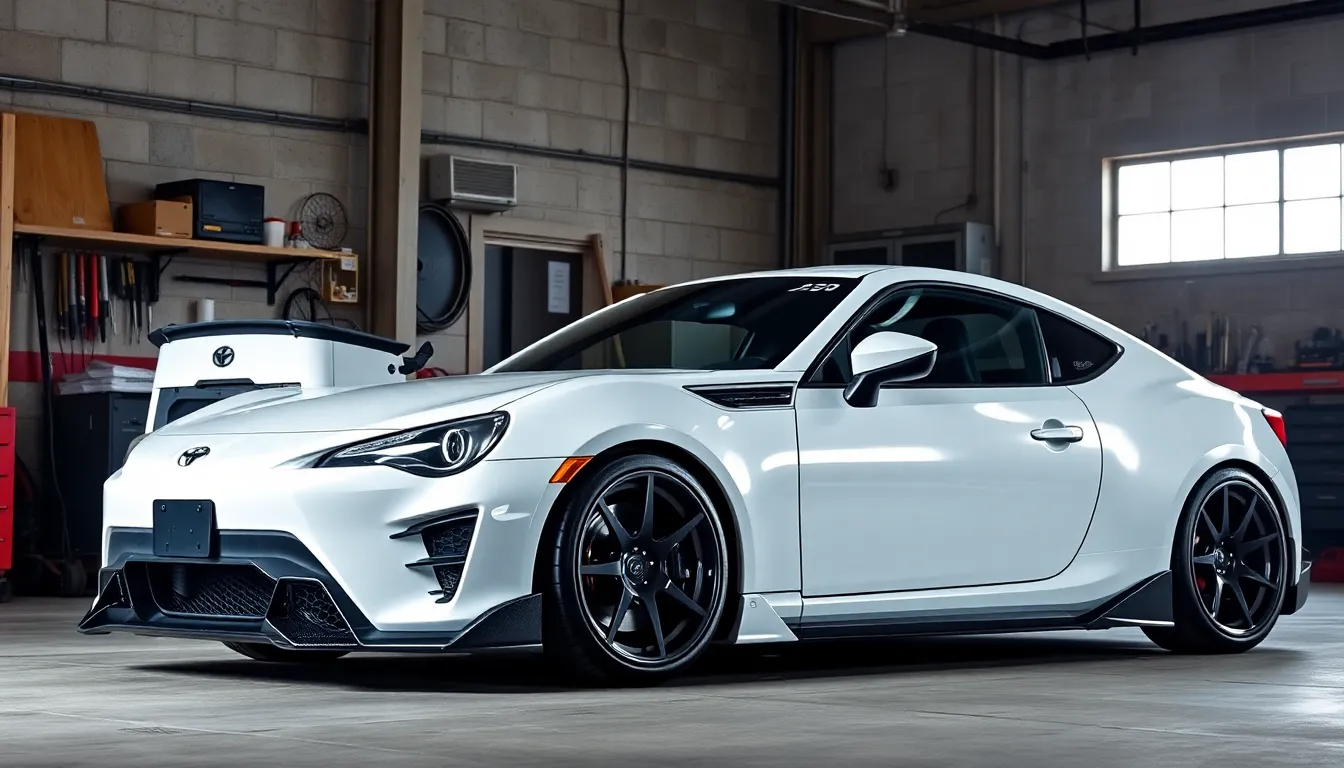
Building too much power without supporting modifications creates the most expensive mistake new Toyota 86 owners make. Forced induction systems generate 280-350 horsepower but require upgraded fuel injectors, ECU tuning, and clutch replacements to handle the increased torque safely.
Choosing cheap coilovers destroys the 86’s balanced handling characteristics that make it special. Entry-level suspension systems under $800 often use inferior damping rates that create harsh ride quality and reduce cornering precision compared to quality options like BC Racing or Tein systems.
Installing widebody kits without professional expertise leads to poor fitment and permanent bodywork damage. Rocket Bunny and Pandem kits require precise cutting and welding that costs $3,000-5,000 when done incorrectly the first time.
Mixing modification philosophies creates cars that excel at nothing while costing maximum money. Track-focused builds with aggressive suspension don’t pair well with show car aesthetics, and street setups lose effectiveness when combined with competition-grade components.
Ignoring the engine’s natural aspirated limits causes reliability problems. Our FA20 engine responds better to bolt-on modifications like cold air intakes and exhaust systems before adding forced induction, maintaining the linear power delivery that defines the driving experience.
Purchasing wheels without considering offset specifications ruins the car’s handling balance. Aggressive fitments with excessive negative camber create uneven tire wear patterns and reduce contact patch size during cornering.
| Common Mistake | Cost Impact | Performance Impact | Solution |
|---|---|---|---|
| Cheap forced induction | $8,000-12,000 | Engine damage risk | Quality turbo kits with supporting mods |
| Budget coilovers | $2,000-4,000 | Poor handling | BC Racing or Tein systems |
| DIY widebody installation | $5,000-8,000 | Bodywork damage | Professional installation |
| Mixed modification styles | $10,000+ | Compromised performance | Choose focused build path |
Skipping professional tuning after engine modifications wastes money and creates dangerous air-fuel ratios. ECU remapping costs $600-800 but prevents engine knock and maximizes power gains from intake and exhaust upgrades.
Buying modifications based on appearance alone ignores functional benefits that enhance driving dynamics. Aerodynamic components like front splitters and rear wings provide downforce at track speeds but add unnecessary weight for street driving.
Rushing into expensive modifications without establishing clear goals leads to buyer’s remorse and incomplete builds. Successful Toyota 86 projects start with exact objectives like daily driving comfort, weekend track performance, or show car aesthetics.
Neglecting maintenance intervals while adding performance modifications accelerates wear on critical components. Turbocharged engines require synthetic oil changes every 3,000 miles and upgraded cooling systems to maintain reliability during aggressive driving.
Conclusion
The Toyota 86 stands as one of today’s most rewarding platforms for automotive enthusiasts seeking to create something truly personal. We’ve explored how this lightweight rear-wheel-drive chassis responds beautifully to modifications ranging from simple bolt-ons to comprehensive builds.
Whether you’re drawn to forced induction setups that double the horsepower or widebody kits that command attention at every car meet the 86 accommodates your vision. The key lies in understanding your goals and building systematically rather than haphazardly throwing parts at the car.
With proper planning and quality components your modified Toyota 86 can deliver thrilling performance while maintaining the daily usability that makes it special. Start with suspension and handling upgrades then progress to power modifications as your budget and experience grow.
Frequently Asked Questions
What makes the Toyota 86 such a popular platform for modifications?
The Toyota 86’s lightweight rear-wheel-drive design, low center of gravity, and affordable price point make it ideal for modifications. Its accessible engine bay accommodates turbocharger kits easily, while the robust six-speed manual transmission handles increased torque well. The suspension system accepts a wide range of aftermarket components, and the RWD configuration eliminates issues like torque steer or understeer.
How much horsepower can I add to a stock Toyota 86?
A stock Toyota 86 produces around 200 horsepower. With turbocharger systems, you can increase this to 280-350 horsepower. Supercharger kits offer similar gains with more linear power delivery. Street-focused builds typically add 50-75 horsepower while maintaining daily drivability, while track-oriented setups can push higher limits with proper supporting modifications.
What are the most effective engine modifications for the Toyota 86?
Forced induction systems like turbochargers and superchargers provide the biggest power gains. Supporting modifications include upgraded fuel injectors, cold air intake systems, and exhaust upgrades like cat-back systems and headers. Professional ECU tuning is essential after major engine modifications to ensure optimal performance and reliability.
Which suspension upgrades provide the best handling improvements?
Coilover systems offer the most comprehensive suspension upgrade, improving cornering precision and reducing body roll. Budget-friendly lowering springs maintain daily drivability while enhancing handling. Sway bars and strut braces increase chassis rigidity and steering feedback. Lightweight wheels paired with performance tires complete the handling package.
What are popular exterior modifications for the Toyota 86?
Widebody kits from brands like Rocket Bunny and Pandem dramatically transform the car’s appearance. Aerodynamic enhancements including front splitters, rear wings, and diffusers provide both aesthetic and performance benefits. Custom paint jobs, vinyl wraps, carbon fiber overlays, and Plasti Dip offer various ways to personalize the vehicle’s look.
How much should I budget for Toyota 86 modifications?
Costs vary significantly based on modification type. Turbocharger kits range from $3,000-$8,000, while supercharger systems cost $4,000-$10,000. Quality coilover systems run $1,000-$3,000. Widebody kits cost $2,000-$8,000 plus installation. Racing seats range from $500-$2,000 per seat. Budget wisely and prioritize modifications based on your specific goals.
What mistakes should I avoid when modifying my Toyota 86?
Avoid building excessive power without supporting modifications like fuel system upgrades and professional tuning. Don’t compromise suspension quality with cheap components that hurt the car’s handling balance. Avoid DIY installation of complex modifications like widebody kits. Don’t mix conflicting modification philosophies, and always maintain regular maintenance intervals to preserve reliability.
Can I modify my Toyota 86 and still use it as a daily driver?
Absolutely. Many modifications enhance both performance and daily usability. Street-focused builds with moderate power gains, quality suspension components, and comfortable interior upgrades maintain practicality. Avoid extremely aggressive modifications like race-only suspension setups or gutted interiors if you plan to drive daily.

